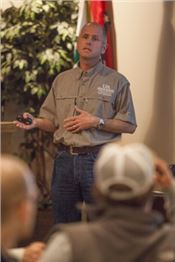|
Arkansas Peanut Acreage Expected To Grow Again In 2016, Experts Plan For Sustainability
JONESBORO, ARK.
Peanut production in the Arkansas Delta is expected to continue moderate growth over 2015 numbers, experts and growers said Thursday at a Craighead County Cooperative Extension Service production meeting in Jonesboro.
After being recognized as a major peanut-producing state by the National Peanut Board in 2014, production jumped about 60 percent in a year’s time, with growers planting more than 16,000 acres in 2015. Travis Faske, extension plant pathologist with the Division of Agriculture, said he now expects an approximately 20 percent growth in acreage over 2015 numbers.
“I expect profitability to stay about the same, given the limited number of buyers in the area and the number of peanuts in storage,” Faske said. “If growers liked how they did last year, they’ll like what they see this year, too.”
Faske has been serving as the Division of Agriculture’s de facto peanut agronomist for several years.
In an age of suppressed commodity crops, the past three years have seen a gradually growing number of cotton growers in the Delta, already sitting atop the requisite sandy loam soil, turn increasingly to peanuts in pursuit of profit.
David Wildy, a Mississippi County producer who said he has primarily farmed cotton for 38 years, planted peanuts for the first time in his career in 2015, breaking ground with 760 acres. At the same time, his family planted about 1,200 acres of cotton – the least amount of land he had ever given to the crop.
“With the new Farm Bill, cotton acreage was basically generic acreage, as far as support went,” Wildy said. “So that gave us a little freedom to maneuver. Peanuts faired a little better under the new bill, and looked more profitable, so we decided to give it a look. We’re on real sandy loam soils in our area, and peanut production was going to fit very well.”
Wildy said peanuts were a natural fit for rotation with cotton. This year, he said he plans to double his peanut acreage, as well as quadrupling his cotton acreage.
As peanut acreage gradually rises in Arkansas, Faske said he hoped to help sustain the growth by getting producers to focus on disease and pest management, rather than ignoring threats until they become a substantial obstacle to profitable production.
“What I tell growers is that we need to think about how we’re going to sustain production for the next 10-20 years,” Faske said. “What do we need to be doing now to reduce disease pressure over a longer period of time, avoiding a spike after four or five years?
“Plenty of growers in other states wish they would’ve had the disease management tools we have at our disposal,” Faske said. “Disease pressure is going to pick up, but if we can just slow it down for a longer period of time, we’ll be in better shape.”
Faske said that many new growers are going through similar “growing pains” as they strive to master a new crop well into established careers, departing from well-worn commodities. In addition to requiring specialized harvest equipment – Wildy calculated a capital outlay of about $280,000 for digging and fluffing equipment – growers must also budget significantly more time for a peanut harvest than they would for soybeans or other row crops.
“On the farm, everything’s pretty fast-paced,” Wildy said. “But with peanuts, you’ve got to slow down. Everything’s a slower pace. You’re going to plant slower, and the harvest is a much slower process.”
Faske said growers should expect to harvest no more than about 30 acres of peanuts per day – about the same amount of time in which growers might harvest 100 acres of beans.
“You might be able to plant fast, but peanuts will slow your overall harvest down,” Faske said. “If you’re a grower and you want to be out of the field by mid-October, you need to think during planting, you need to aim for having mature peanuts well in advance of Oct. 1, depending on how many acres you’re talking about. If you’re still out there in November, you could run into problems with having peanuts rotting in the field.” ∆

Travis Faske, plant pathologist for the University of Arkansas System Division
of Agriculture and acting peanut agronomist, speaks to a room of about 40
producers and consultants during a March 3, 2016 peanut and cotton production
meeting at the Craighead County Cooperative Extension office.
Ryan McGeeney, U of A System Division of Agriculture
|
|